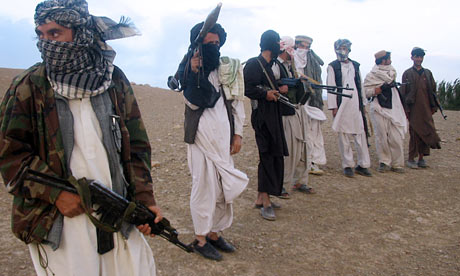Taliban Says U.S. Decision To Keep Troops In Afghanistan "Damages Prospects For Peace"
Taliban vows to continue fighting

NEW DELHI: The Taliban has reacted sharply to the White House’s announcement that the United States will maintain its current 9800 troops in Afghanistan through the end of 2015. "This damages all the prospects for peace, Taliban spokesman Zabihullah Mujahid said of the announcement. “This means the war will go on until they are defeated.”
The announcement that the US will leave 9800 troops in the country -- as opposed to an earlier plan of cutting the number to 5500 --and the following statement by the Taliban come as reports circulate of a possible dialogue between the Afghan government and the Taliban.
In fact, Afghan President Ashraf Ghani recently said "the grounds for peace have never been better in the last 36 years.” It is likely that the US’ announcement to slow down the removal of troops and the Taliban commitment to push through with the fighting will jeapordize the peace process in the deeply troubled country.
Violence in Afghanistan is on the upswing, necessitating mechanism for peace and resolution to be put in place. The UN Mission in Afghanistan has said that the number of civilians killed or wounded in the troubled country climbed by 22 percent in 2014 to reach the highest level since 2009.
The UN agency documented 10,548 civilian casualties in 2014, the highest number of civilian deaths and injuries recorded in a single year since 2009. They include 3,699 civilian deaths, up 25 per cent from 2013 and 6,849 civilian injuries, up 21 per cent from 2013. Since 2009 -- when UNAMA began tracking casualties -- the armed conflict in Afghanistan has caused 47,745 civilian casualties with 17,774 Afghan civilians killed and 29,971 injured.
The UN says that Taliban militants -- who have been waging an insurgency in Afghanistan since a US-led invasion toppled their government 13 years ago -- were responsible for 72 per cent of all civilian casualties, with government forces and foreign troops responsible for 14 percent.
For the first time since 2009, more Afghan civilians were killed and injured in ground engagements than by improvised explosive devices (IEDs) or any other tactic. The report found that civilian deaths and injuries from ground operations surged by 54 per cent making them the leading cause of civilian casualties and the biggest killers of Afghan women and children in 2014.
The rise in civilian casualties in 2014 resulted mainly from increased ground engagements across Afghanistan in which parties to the conflict increasingly used explosive weapons systems such as mortars, rockets and grenades, sometimes indiscriminately, in civilian-populated areas with devastating consequences for civilians. The increased indiscriminate use of IEDs and increased number of suicide attacks by Anti-Government Elements added to the rising civilian casualties in 2014.
“In communities across Afghanistan, increased ground fighting among parties to the conflict and more IED attacks exacted a heavy toll on Afghan civilians,” said the United Nations SecretaryGeneral’s Special Representative for Afghanistan and head of UNAMA, Nicholas Haysom. “Rising civilian deaths and injuries in 2014 attests to a failure to fulfil commitments to protect Afghan civilians from harm. Parties to the conflict should understand the impact of their actions and take responsibility for them, uphold the values they claim to defend, and make protecting civilians their first priority. We need to see concrete steps and a real drop in civilian casualties in 2015.”
The report also noted that women and children were particularly hard hit by the armed conflict and increased ground engagements in 2014. UNAMA documented a 40 per cent increase in children casualties with 2,474 children casualties (714 killed and 1,760 injured) compared to 2013. Women casualties increased by 21 per cent with 298 women killed and 611 injured.
To highlight the broader social and economic impact of the conflict on the lives of Afghan women, UNAMA interviewed 60 women from all regions in Afghanistan whose husbands, all civilians, were killed or seriously injured from conflict-related violence in 2014. UNAMA found that women who were left as sole income-providers for their households after the death or injury of their husbands often experienced long-term negative social and economic consequences, with poverty forcing many women to give their daughters in marriage in exchange for debts or to take their children out of school often to work. Widowed women were often particularly vulnerable to other forms of violence and abuse from family and community members. These findings call for urgent action by the Government of Afghanistan to address the basic needs of this group of very vulnerable and often marginalized women and their children, the report says.
“For Afghan women and children, the anguish of losing a husband and father in the conflict is often only the beginning of their suffering and hardship,” said the UNAMA Director of Human Rights, Georgette Gagnon. “The long-term social and economic consequences are devastating affecting the most vulnerable the hardest. After a year in which conflict-related violence led by ground engagements killed and injured record numbers of women and children, the destruction and damage to Afghan lives must be met with a new commitment by all parties to avoid harm to Afghan civilians.”



